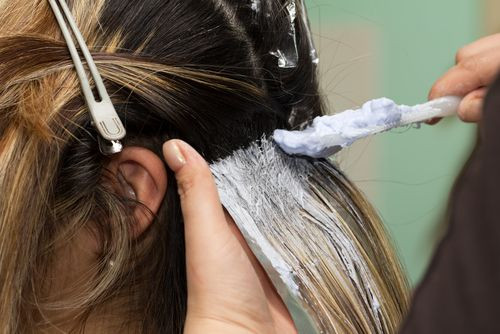Hair Dyes May Still Cause Cancer: Known Carcinogens Found In Hairdressers' Blood

With over 5,000 chemicals in a hair dye product — they’re powerful, after all — some of them were bound to have some harmful effects. In the late 1970s, scientists discovered that 89 percent of formulations contained carcinogenic chemicals. So, dye manufacturers began using different chemicals, and some of those that were deemed carcinogenic, such as aromatic amines, were banned in cosmetic products in the European Union (The FDA regulates these products on a case-by-case basis.). But a new study from Lund University in Sweden has found that hairdressers may still be exposed to these carcinogens, and if so, they’re getting in their blood every time someone walks into the salon.
According to the National Cancer Institute, permanent hair dyes, also called oxidative dyes, are the ones most dangerous to hairdressers. Making up almost 80 percent of the dye market, people go to them because the only way to remove them is to grow out new hair. They work with the help of hydrogen peroxide, which causes a chemical reaction between so-called “intermediates” — the aromatic amines — and dye “couplers.” In turn, the chemical reaction causes pigment molecules to form.
Many of the aromatic amines called toluidines have been implicated in causing cancer, but ortho-toluidine (o-toluidine) has actually been confirmed as a carcinogenic. Altogether, these chemicals have been suspected of causing bladder cancer, non-Hodgkin lymphoma, leukaemia, and breast cancer. Considering the severity of these cancers, it would be in everyone’s best interest to know what they’re touching when they come into contact with hair dyes.
For their study, the researchers looked at o-toluidine levels in the blood, along with levels of seven other aromatic amines. Specifically, they looked at structures in the blood called hemoglobin adducts, which gave them a sense of long-term exposure to the carcinogen, as they showed how many molecules of hemoglobin had attached to molecules of the toluidines.
Testing this method on 295 female hairdressers, 32 regular users of hair dye, and 60 people who hadn’t used any products in a year, they found that hairdressers were indeed exposing themselves to o-toluidine and meta-toluidine (m-toluidine). What’s more, hairdressers who performed more weekly hair dye or hair waving treatments tended to have higher concentrations of the carcinogens.
“The latter was somewhat unexpected, but analysis of a common randomly-chosen product confirmed the presence of both o- and m-toluidine,” the researchers wrote. They added that even with the variety of products hairdressers use, they were able to narrow down the source of o-toluidine to “light-color permanent hair dyes and hair waving.”
The findings may be especially troubling for hairdressers in Sweden, since most of the study population was based in the southern province of Scania in Sweden. The researchers called for further studies into the ingredients of current dyes, as the probability that these chemicals are being transferred from dyes and hair into water systems, the air, and the food supply.
Source: Johansson G, Albin M, Lidén C, et al. Exposure of hairdressers to ortho- and meta-toluidine in hair dyes. BMJ Occupational & Environmental Medicine. 2014.
Published by Medicaldaily.com



























